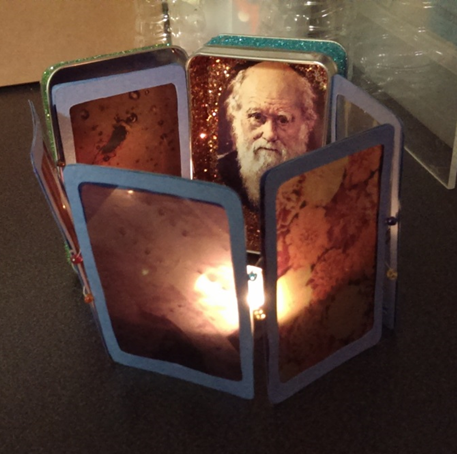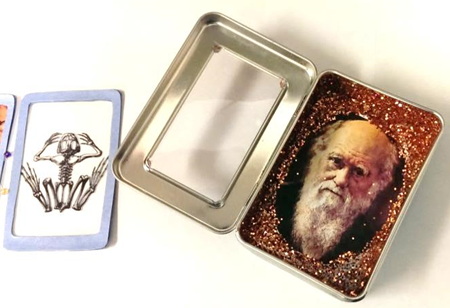If you have been following along, you might have noted that Dia de los Muertos — Day of the Dead — is a favorite holiday for the Youth Education staffers.
The Day of the Dead is celebrated in Mexico on Nov. 2. It is a time when Mexican families spend time at the cemetery, visiting the graves of their relatives, cleaning and perhaps painting the headstones, arranging flowers, especially flowers of the dead (marigolds) and lighting candles.
It is also the time when Mexican families construct special home altars dedicated to the spirits of their deceased loved ones. The altars range from simple to the very elaborate and are usually filled with objects that provided pleasure to the departed person in life, including favorite food and drink. Altars dedicated to the spirits of deceased children often include toys, candy and other sweets.

The altars usually contain objects with significant meaning. These objects can be either the actual thing or a representation.These objects include, but aren’t limited to:
Pictures of the deceased and/or representations of saints: These are used as a focus for the shrine and may help determine the direction of the rest of the altar. For example, Frida Kahlo is a popular topic for altars. An altar to her may be very different than one for a personal relative.
Marigolds: The flower cempazúchil, also known as the marigold, is the flower of the dead. Its yellow orange color can be seen from far away; therefore the flowers are the first beacon the dead will see. A trail of flowers leads the dead home where the altar is awaiting their arrival.
Copal: Copal is aromatic tree resin burned in Mesoamerica as incense. Several different tree resins bear the name copal. Copal is burned on the altar so that the dead might recognize the aroma of their home and feel welcome.
Pan de Muerto and other foods: These are offered to the spirit of the dead to help sustain them in the afterlife.
Candles: The candles on an altar represent fire, one of the four essential altar elements. Candles are included in the altar to purify and to provide light to the dead to help them find their way home. One candle is included on the altar for each deceased that is being remembered.
Skulls and skeletons: Sugar skulls are a traditional folk art from southern Mexico used to celebrate Day of the Dead. Mounds of colorful sugar skulls are sold by Indian vendors in open air village markets during the week preceding the holiday. Sugar skulls are colorfully decorated with icing, pieces of bright foil, colored sugars and usually bear the name of the deceased loved one being honored. The calaca is a model of a skeleton that can be found doing any number of things that the dead may have enjoyed in life, from riding a bike to dancing. The calaca reminds us that death is not something to fear. The calaca also shows us that no soul likes to be remembered sadly. Papier-mâché skeletons and skulls are used to add flair, beauty and a festive air to the Day of the Dead. Mexican folk artists spend all year crafting this very special type of art.
Since it is unlikely that you will be able to take your students to the graveyard of a famous scientist or celebrity to construct an altar in their honor, we are proposing that you bring the altars to your classroom! This small and potentially free classroom activity involves research, informative writing, creative thinking and a little bit of arts and crafts for good measure. Enjoy!
Materials:
Altoids tin or other similar tin
Quick dry craft glue
A nail or other scratching device
Tissue paper
Scissors
Pens, pencils, markers etc.
Magazines
Any other found objects you choose – it can be anything you want to give students access to or anything they can bring in.

Procedure:
1. The project can contain either purely artistic merit or it can have a writing component to add higher level thinking and make it multidisciplinary and applicable to any class. This project is written to include the composition portion, but feel free to eliminate it if you choose.
2. Explain the purpose of an altar for Dia de los Muertos as well as the traditional elements of an altar to your class.
3. To begin, have students research an historical figure or relative of their choice. The figure must be deceased. You may want to set some limits of the choices (must have died at least 50 years ago, must be from a specific country, must be a writer/scientist, can’t be an actor or musician, etc.).
4. Once the students have selected a figure and you have approved of the choice, you will want to provide a rubric, format or objective for the students. Depending on the grade level, you may want to structure the composition around a particular TEKS writing objective or prompt. For example:
- > 3rd graders need to communicate with a variety of audiences and learn the basics of research.
- > 4th and 5th graders need to persuade and inform in their writing.
- > 6th graders need to write about their own experiences and write persuasively.
- > 7th graders need to write about their own experiences and write persuasively.
- > 8th graders need to write a personal essay and write persuasively.

So in any of these examples, you could have students make a case for a particular historical figure or family member. The choice of writing composition will be left to you.
5. Now you will need to provide students with their tin. You can either order them from a number of various sources for about $0.30 each or you can have students collect or provide Altoids tins. These will be free to you! The advantage to the tins as opposed to a larger classroom altar is the storage requirements and the cost.
6. Review the Day of the Dead altar and its components again. Explain to your students that they will be making a complete altar for their figure. They must include all of the elements of the traditional altar. Due to the space restrictions, however, they must get creative! For older students, you will need to talk about symbolism and encourage them to incorporate this into their altars while still fitting the figure in question. For example, a student picks Thomas Edison. Rather than a candle, the student might opt for a magazine cutout of a light bulb to represent both light and illumination AND one of Edison’s inventions; or students could add overly large ears to their skulls to show that Edison was largely deaf.
7. Let students have access to anything and everything consumable that might work into their altar. You may want them to collect items to bring in and share. Even very unconventional items will be great as part of the challenge is creativity. It will be up to you to decide whether to let students work on their tins in class or at home, but it may be a good idea to let them at least discuss ideas in small groups so they can help each other develop ideas. This will be particularly effective after researching the figure because they will have more information to provide to their classmates about their figure (like the invention of the light bulb and deafness for Thomas Edison).
8. As the students are working on their altars, have them make a note of how they incorporated each of the altar elements in a meaningful way. This should be turned in as part of the altar. See the example included below.
9. Once the students’ tins are complete, have them create a little class art gallery or museum so that all of students can see the creativity of the other students. You may want to create a survey for the students to fill out regarding the altars to make sure that they are taking their time and absorbing the information provided. Some example questions might include:
- > Which altar is your favorite? Why?
- > List three interesting or surprising facts you learned. Each fact must come from a different altar.
- > Name one symbol from one altar that you might have represented differently. How would you have done it?

10. Additionally, you might want to display altars in the library or display cases, have students present their findings to the class using PowerPoint, have students translate their symbol information into Spanish, etc.
As an example, I have included pictures of my tin altar and an explanation of my components:
Example Explanation of Altar Symbols
Explanation of Altar Symbols
Pictures: I chose this particular portrait of Charles Darwin because it was one of the last made during his lifetime. Additionally, it is a painting rather than photograph. Most of the images available of Darwin as an adult are photographs and I like to think, with all of the scientific and technological change that occurred during his time, that the last image of his was created using very traditional methods.
Marigolds/Candles: The origin of the word “marigold” is probably a reference for the Virgin Mary or possible refers to its original name in old Saxon which meant “it turns with the Sun.” So the image of marigolds does triple duty: it refers to a saint, it represents grave flowers, and it represents light.
Copal: I left traditional copal as part of my altar because Darwin originally joined the HMS Beagle crew as a geologist. Copal, like amber, are both considered fossils and are important clues in determining the flora and fauna of a particular area of time in the fossil record.
Pan de Muerto and other foods: I have included a picture of hardtack rather than pan de muerto. Both are bread-based but the hardtack was a common food substance on ships as it kept for a long time in the holds.
Skulls and skeletons: The skeleton I included is of a frog because one of the many contributions Darwin made to science was in identifying a species of frog, named “Darwin’s frog”, as part of his travels on the HMS Beagle.





